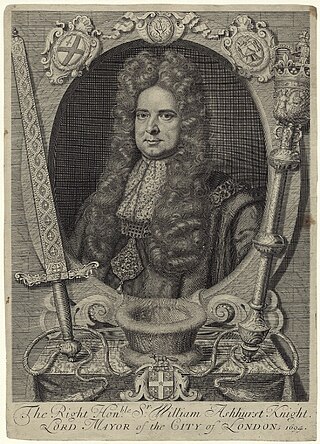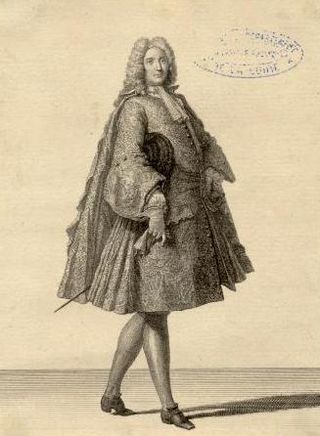Related Research Articles

Field Marshal George Hamilton, 1st Earl of Orkney,, styled Lord George Hamilton from 1666 to 1696, was a British soldier and Scottish nobleman and the first British Army officer to be promoted to the rank of field marshal. After commanding a regiment for the cause of William of Orange during the Williamite War in Ireland, he commanded a regiment in the Low Countries during the Nine Years' War. He then led the final assault at the Battle of Blenheim attacking the village churchyard with eight battalions of men and then receiving the surrender of its French defenders during the War of the Spanish Succession. He also led the charge of fifteen infantry battalions in an extremely bloody assault on the French entrenchments at the Battle of Malplaquet. In later life, he became a Lord of the Bedchamber to George I and was installed as Governor of Edinburgh Castle.

Sir Gilbert Heathcote, 1st Baronet was an English merchant and Whig politician who sat in the English and British House of Commons between 1701 and 1733. He also served as the governor of the Bank of England and was Lord Mayor of London in 1711.

John Hay, 2nd Marquess of Tweeddale PC was a Scottish nobleman.
Sir William Withers of Fulham, Middlesex, was an English linen draper and Tory politician who sat in the English and British House of Commons between 1701 and 1715. He was Lord Mayor of London from 1707 to 1708.

Philip Bisse was an English bishop.
Lieutenant-General Harry Mordaunt was an English Army officer and Whig politician who sat in the English and British House of Commons between 1692 and 1720.
Sir Francis Dashwood, 1st Baronet, of St. Botolph without Bishopsgate, London, and West Wycombe, Buckinghamshire, was a British merchant, landowner and Whig politician who sat in the House of Commons from 1708 to 1713.
The Hannibal was a slave ship, hired by the Royal African Company of England. The ship participated in two slave trading voyages, in the Triangular Trade. The wooden sailing ship was 450 tons and mounted with thirty-six guns. The ship is most remembered for her disastrous voyage of 1693–95. Captain Thomas Phillips commanded the Hannibal. He was a Welsh sea captain from Brecon, Wales who was employed by the Sir Jeffrey Jeffreys, and others. who owned the Hannibal and were governors and Assistants in the Royal African Company.

Sir William Ashhurst was an English banker, merchant and Whig politician who sat in the English and British House of Commons from 1689 to 1710. He also served as the Lord Mayor of London in 1693.

Sir John Cass was an English merchant, Tory Member of Parliament and philanthropist. He was also a key figure in the Royal African Company, which was involved in the Atlantic slave trade.

Sir Bevil Granville MP JP was an English soldier and politician from Cornwall, who was MP for Fowey and Lostwithiel from 1690 to 1698. He also served as Governor of Pendennis Castle from 1693 to 1703 and Governor of Barbados from 1703 to 1706, and died at sea on his return voyage to England in September 1706.
Sir Charles Peers was a British businessman who became the Chairman of the East India Company in 1714 and Lord Mayor of London in 1715. He had previously served as one of the Sheriffs of the City of London in 1708–1709.

Yves d'Alègre. He was the fifth head of the Alègre family, and marquis of Tourzel as well as seigneur of Montaigu, of Saint-Flour-le-Châtel, of Aurouze and of Aubusson and count of Flaugeac.
Sir Owen Buckingham was an English merchant, alderman, MP and Lord Mayor of London.

Sir John Parsons of The Priory, Reigate, Surrey, was an English brewer, Royal Navy victualler and Tory politician, who sat in the English and British House of Commons between 1685 and 1717. He was Lord Mayor of London in 1703.

Micajah Perry was a British tobacco merchant and politician who sat in the House of Commons from 1727 to 1741. He was Lord Mayor of London in 1738.
Sir Robert Bedingfield (1637–1711) of Ludgate Street, London, was a British merchant and politician who sat in the House of Commons in 1701. He was Lord Mayor of London in 1706.
Sir William Lewen, of Ewell, Surrey, was a British merchant and Tory politician who sat in the House of Commons between 1708 and 1722. He was Lord Mayor of London in 1717.

Sir Charles Hobby (1665–1715) was a Boston merchant and militia colonel, commanding a provincial regiment during the siege of Port Royal 1710, and serving as its acting governor in 1711. He was knighted in 1705.

Thomas Hill (c.1645–1713) was a 17th/18th century English sculptor, based in London.
References
- ↑ John Strype (ed.) John Stow A Survey of the Cities of London and Westminster 1720
- ↑ "James Stanier - MarineLives". www.marinelives.org. Retrieved 27 February 2021.
- ↑ Davis, K. G. (1957). The Royal African Company. London: Longmans, Green & Co. p. 160.
- ↑ Caldicott, Rosemary L (2024). Voyage of Despair. The Hannibal, its captain and all who sailed in her, 1693-1695. Bristol: BRHG Books. pp. 90, 205. ISBN 978-1-911522-63-8.
- ↑ The National Archives, Kew, London. T70/61 f.106
- 1 2 Alfred P Beaven. "'Chronological list of aldermen: 1701-1800', in The Aldermen of the City of London Temp. Henry III - 1912 (London, 1908), pp. 119-140". British History Online. Retrieved 14 December 2018.
